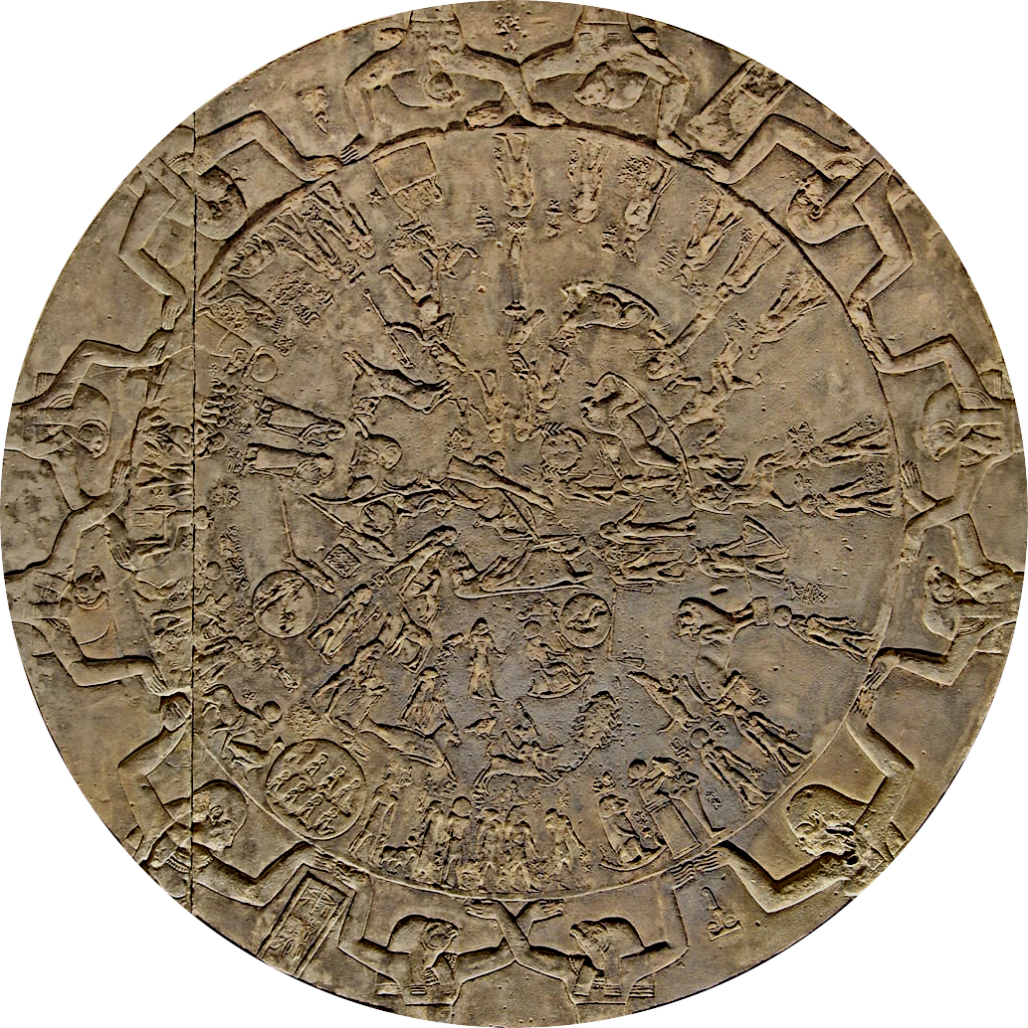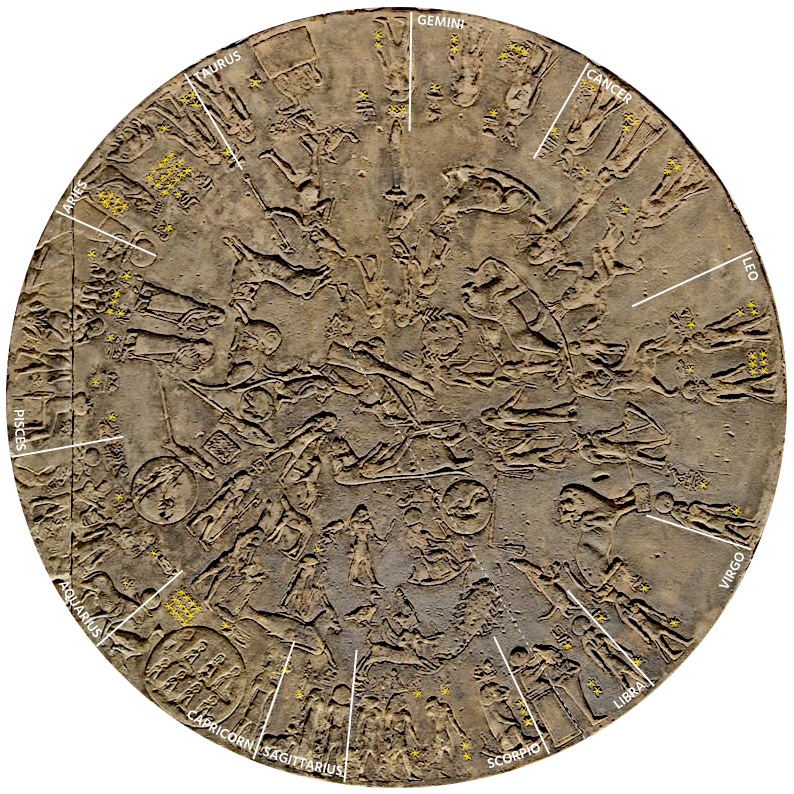The Dendera Zodiac
Neptune
Page controls
This website animates the sculpture using the NASA DE441 and DE431 ephemerides, which contains the highly accurate positions of the solar system planets, as its data sources for the angular rotations that
are applied to the sculpture's component parts. This data is available in the right panel of this page in the 'technical data' tab. The animation can be reset at any time by clicking the button below and
the zodiac carvings on the inner circle of the sculpture can be viewed at any time by clicking on the other button.
(Click and hold)
This particular webpage, on the right side panel, explains the sculpture's Neptune model and follows on from the previous page which explained the Uranus system.
It is advised to read that page before reading this one.
Neptune carving

Explanation
Technical data
Neptune
Zodiac sign Sagitarius
The carving of the God that represent Neptune on the Dendera Zodiac has never been previously identified because there has always been the incorrect assumption
that there are only five planets represented in the Dendera Zodiac.
This assumption is based on the fact that there are only five Gods/planets on the central circle that are named using hieroglyphs and the fact that the planet Neptune is invisible to the naked eye, meaning that it was not identified as being a planet until the advent of telescopes and was first documented in modern times in the year 1846. The God representing Neptune is shown on the left panel of this page in detail and is highlighted on the central circle of the main dynamic illustration.
The alignment line of the God with the starting point of the planet is set at exactly 42 degrees to the principal God's line and does not deviate when it reaches that line but continues straight on and aligns perfectly with the vertical box like object on the outer circle of the sculpture. The alignment line is shown in yellow on the image of the God in the left panel and aligns with the lower part of the bow and the God's left upper arm. The vertical box carving has an explicit central reference line carved on it which allows the Neptune alignment to be perfectly determined.
The first step in the dynamic process is to align the zodiac portion of the inner circle to its correct position.
This assumption is based on the fact that there are only five Gods/planets on the central circle that are named using hieroglyphs and the fact that the planet Neptune is invisible to the naked eye, meaning that it was not identified as being a planet until the advent of telescopes and was first documented in modern times in the year 1846. The God representing Neptune is shown on the left panel of this page in detail and is highlighted on the central circle of the main dynamic illustration.
The alignment line of the God with the starting point of the planet is set at exactly 42 degrees to the principal God's line and does not deviate when it reaches that line but continues straight on and aligns perfectly with the vertical box like object on the outer circle of the sculpture. The alignment line is shown in yellow on the image of the God in the left panel and aligns with the lower part of the bow and the God's left upper arm. The vertical box carving has an explicit central reference line carved on it which allows the Neptune alignment to be perfectly determined.
The first step in the dynamic process is to align the zodiac portion of the inner circle to its correct position.
The Neptune God's alignment line defines the Sagittarius zodiac division by aligning with its central point that is half way between the two white marker points on the outside inner circle.
The 42 degree angle that is subtended between the two lines is the same as that used for the bow and arrow that is included in the Neptune God carving and consequently the
two ends of the line have the same geometric architecture.
The first of the astronomy angles can now be applied to the dynamic illustration noting carefully that the rotation takes the alignment line from its position at the center of the vertical box to the vertical box's left edge.
The first of the astronomy angles can now be applied to the dynamic illustration noting carefully that the rotation takes the alignment line from its position at the center of the vertical box to the vertical box's left edge.
The second of the astronomy angles that defines the periapsis point is the next angle to be applied.
The true anomaly can finally be applied to Neptune and the planet ends up in the winter solstice alignment circles correctly positioned as the eighth planet from the Sun.
With Neptune being the outer and last planet of the solar system and with its starting position being marked out so explicitly on the vertical box's central axis, the final position
of the planet in the winter solstice area on the left of the outer frame is crucial in determining the size of the planet alignment circles. What is needed to complete the determination
of these circle's sizes is the mid point planet, Mars, which is the final planet in the sequence.
The technical data from the NASA ephemerides that is used to perform the astronomy rotations along with technical notes regarding the rotations is listed in the technical data tab at the top of this panel.
Due to the logic used in the design the planets have to be solved in a particular order, the final of these being Mars.
Click here to be taken to the Mars page.
The technical data from the NASA ephemerides that is used to perform the astronomy rotations along with technical notes regarding the rotations is listed in the technical data tab at the top of this panel.
Due to the logic used in the design the planets have to be solved in a particular order, the final of these being Mars.
Click here to be taken to the Mars page.










